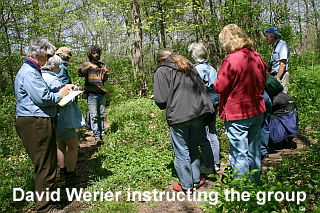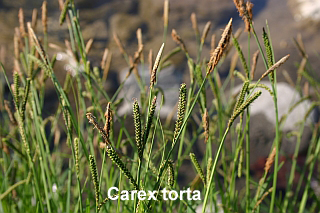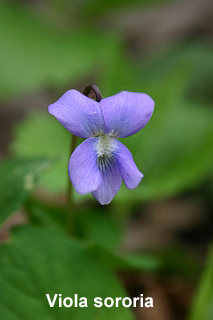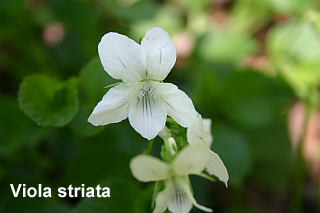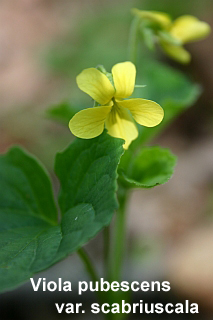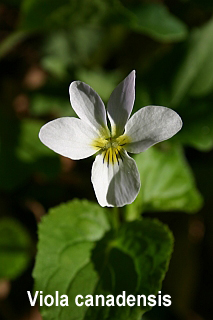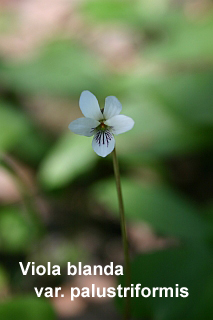Viola (Violets)
When
What
Where
Who
Description
There could be no better time than Mother’s Day to appreciate the genus Viola. During this outing we will focus on identification of the rich violet diversity that occurs where we live. We will travel to various sites to see as much of this diversity as possible. Expect to focus your attention on these showy but small plants. Led by David Werier.
Meet at CCE at 1 pm.
Report
Sunday,
The first place we went was Lower Treman. We parked at the Lick Brook parking area then walked under a highway bridge towards Treman State Park. David stopped us right after the overpass to point out the sedge,Carex torta. This is a beautiful sedge, about 2 1/4 ft. tall. The female flowers catch the eye.
Viola sororia, the Common Blue Violet has large, cordate (heart-shaped), hairy, leaves. Each dark blue flower of this violet, like all violets, consists of five petals: 2 upper, 2 lateral and one lower called the 'lip'. The lower petal is spurred. On some violets, the lateral petals have 'beards' near their bases. The shape of the filaments constituting the beard are a key diagnostic feature. V. sororia is an acaulescent or stemless violet in that both the leaves and flowers arise from a rhizoid.
At the same site,Viola striata, the Pale Violet or Cream Violet, grew. Unlike V. sororia, this lovely white is caulescent. It belongs to the group of violets whose leaves and flower arise from a common stem. It is creamy white with dark blue lines, known as 'nectar lines', on the lower lip. The lateral petals are heavily bearded. Another diagnostic feature is the coarsely toothed stipules, the tiny pair of leaf-like structures located where the petioles meet the main stem.
We continued on the trail, passing woods abloom in our spring wildflowers. We passed Wild Ginger, Solomon's Seal, False Solomon's Seal, Sharp-lobed Hepatica and Virginia Bluebells.
Next wasViola pubescensvar.scabriuscula, the Downy Yellow Violet. This is another caulescent violet but with yellow flowers. It stands 8" to 16" tall. The back of the petals have a reddish tint and the heart-shaped leaves, as well as the stems, are usually covered with downy hairs. Another characteristic to look for is the presence of two or more basil leaves.
We left Treman and drove to Upper Buttermilk Falls. The park had already opened for the season so each car contributed six dollars. We found a white form of V. sororia with a blueish tinge as well as some others that were entirely white.
The first new violet at Buttermilk is distinctive. It isViola rostrata, the Long-spurred Violet. The spur on this species is the longest spur of any violet in this area, nearly 1/2" to 1" long, and is visible even when viewing the violet head-on. The petals are pale lavender with a dark center ('eye') and the lip has dark-blue nectar lines. Its petals are beardless and it has coarsely toothed stipules. It stands about five inches tall.
Continuing on to a rich woody area, we foundV. canadensis, the Canada Violet. A patch of these violets were growing in the fertile soil deposited as a result of frequent flooding of the adjacent Buttermilk Creek. This is one of our larger white violets, standing up to 16" tall, and the flower sports a large yellow eye. The backs of the petals are lilac-shaded and the stipule margins are hyaline (transparent). The stems may be purplish with some hairs. The leaves are cordate.
We again encountered numerous spring ephemerals along the way. We saw beautiful clumps of Wild Columbine, Sweet Cicely, Rue Anemone, and several Buttercup species. A special find was the uncommonBotrychium virginiana, Rattlesnake Fern, whose ancestry dates far back in time.
A small but common violet,Viola blanda var.palustriformis, was seen along the path. This "Sweet White Violet" is acaulescent and has distinctively deep lobes at the base of its leaves, making them appear to almost overlap. It is one of several species of acaulescent white violets with very small flowers. The flowers are much smaller than those of V. striata or the white form of V. sororia. The flower is fragrant with twisted upper petals. The stems are reddish.
The last violet we had the pleasure of seeing wasViola cucullata, the Marsh Blue Violet, in a wetter area of the park. Its lateral petals are bearded with short, clubbed filaments and the central part of the flower is a dark blue. The flower stem of this lovely blue is long; taller than the long, pointy, leaves which are often curled. The lower petal is veined and shorter than the other petals. The entire plant is glabrous (hairless).


